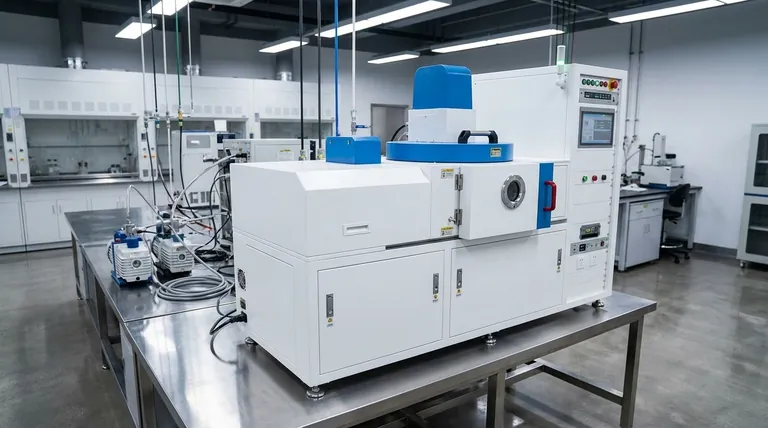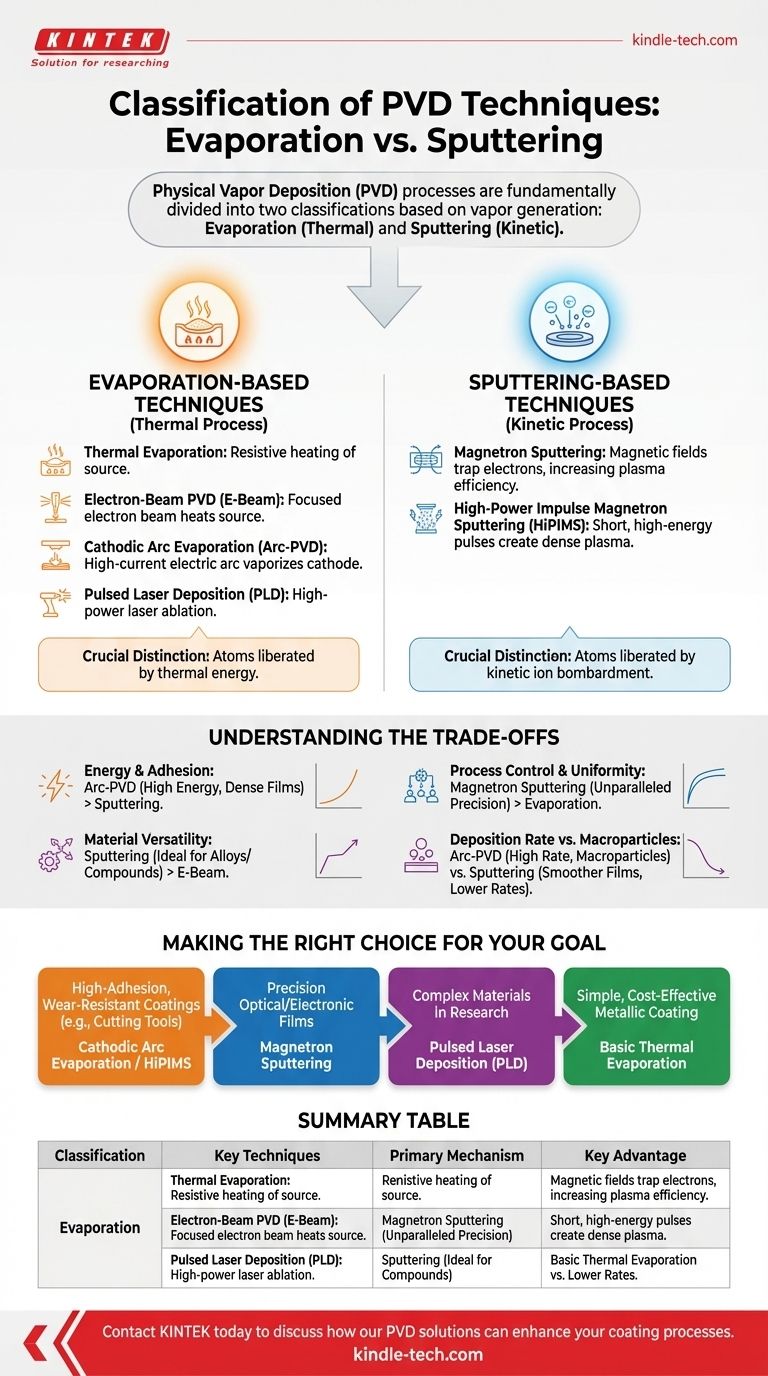At its core, Physical Vapor Deposition (PVD) is a family of processes divided into two fundamental classifications. These classifications are based on the primary mechanism used to generate vapor from a solid source material: Evaporation and Sputtering. All specific PVD techniques, from simple thermal evaporation to advanced high-power sputtering, fall under one of these two umbrellas.
The crucial distinction is how atoms are liberated from the source material. Evaporation is a thermal process, like boiling a metal, while Sputtering is a kinetic process, like sandblasting a target at the atomic level. This difference dictates the energy of the depositing particles, the quality of the film, and the ideal applications for each technique.

The Two Pillars of PVD: Evaporation vs. Sputtering
Understanding these two foundational methods is the key to navigating the landscape of PVD technologies. They represent different approaches to achieving the same goal: creating a vapor of material that can be condensed onto a substrate as a thin film.
Evaporation-Based Techniques
Evaporation processes use thermal energy to raise the vapor pressure of a solid source material to the point where it vaporizes within a vacuum chamber.
- Thermal Evaporation: This is the simplest form, where a source material is heated by a resistive element (like a tungsten boat) until it evaporates and coats a substrate.
- Electron-Beam PVD (E-Beam PVD): An intense, focused beam of electrons heats the source material. This method is ideal for materials with very high melting points that cannot be vaporized by simple resistive heating.
- Cathodic Arc Evaporation (Arc-PVD): This technique uses a high-current, low-voltage electric arc to vaporize the cathode source material. This creates a highly ionized vapor, resulting in extremely dense films with excellent adhesion, making it a top choice for hard coatings on cutting tools.
- Pulsed Laser Deposition (PLD): A high-power laser is focused on the target material, causing an explosive evaporation event called ablation. This is particularly useful for depositing complex materials because the composition of the vapor often matches the source material very closely.
Sputtering-Based Techniques
Sputtering processes use a plasma to generate energetic ions (typically argon) that are accelerated toward a source material, known as the "target." The impact of these ions ejects or "sputters" atoms from the target, which then travel to and deposit on the substrate.
- Magnetron Sputtering: This is the most dominant PVD technology in industry. It uses strong magnetic fields behind the target to trap electrons, which dramatically increases the efficiency of the plasma and allows for much higher deposition rates at lower pressures.
- High-Power Impulse Magnetron Sputtering (HiPIMS): This is an advanced form of magnetron sputtering that applies power in very short, high-energy pulses. This creates a dense plasma with a high degree of ionization, combining the benefits of sputtering control with the high film quality of arc evaporation.
Understanding the Trade-offs
Choosing between evaporation and sputtering is a matter of balancing competing priorities. No single technique is universally superior; the right choice depends entirely on the application's requirements.
Energy and Adhesion
Arc evaporation techniques impart the highest energy to the depositing particles. This high energy results in denser films and superior adhesion to the substrate, which is why it is favored for demanding wear-resistant applications.
Process Control and Uniformity
Sputtering, particularly magnetron sputtering, offers unparalleled control over film thickness, composition, and uniformity over large areas. This precision is essential for manufacturing optical filters, semiconductors, and other microelectronic components.
Material Versatility
While E-Beam PVD can handle high-temperature materials, sputtering is exceptionally versatile for depositing alloys and compounds. The composition of the sputtered film can be precisely controlled by adjusting the target material and process gases.
Deposition Rate vs. Macroparticles
Arc evaporation typically has a very high deposition rate but can produce "macroparticles" (small droplets of the source material) that can be detrimental to the film's surface finish. Sputtering produces smoother films but can sometimes have lower deposition rates.
Making the Right Choice for Your Goal
Your specific goal determines which branch of the PVD family is most suitable.
- If your primary focus is high-adhesion, wear-resistant coatings (e.g., cutting tools): Cathodic Arc Evaporation or advanced sputtering like HiPIMS are the leading industrial choices.
- If your primary focus is precision optical or electronic films: Magnetron Sputtering offers the best control over thickness, uniformity, and material composition.
- If your primary focus is depositing complex materials in a research setting: Pulsed Laser Deposition (PLD) provides excellent transfer of stoichiometry from the target to the film.
- If your primary focus is a simple, cost-effective metallic coating: Basic Thermal Evaporation is often the most straightforward and economical method.
Ultimately, classifying PVD techniques begins and ends with understanding the fundamental difference between evaporation and sputtering.
Summary Table:
| Classification | Key Techniques | Primary Mechanism | Key Advantage |
|---|---|---|---|
| Evaporation | Thermal, E-Beam, Arc-PVD, PLD | Thermal Energy | High deposition rates, excellent for hard coatings (Arc-PVD) |
| Sputtering | Magnetron, HiPIMS | Kinetic Energy (Ion Bombardment) | Superior control, uniformity, ideal for optics/electronics |
Struggling to select the right PVD technique for your specific application? The choice between evaporation and sputtering is critical for achieving optimal film quality, adhesion, and performance. KINTEK specializes in providing advanced lab equipment and consumables for all your PVD needs. Our experts can help you navigate these classifications to find the perfect solution for your laboratory's research or production goals.
Contact KINTEK today to discuss how our PVD solutions can enhance your coating processes and deliver superior results.
Visual Guide

Related Products
- RF PECVD System Radio Frequency Plasma-Enhanced Chemical Vapor Deposition RF PECVD
- Split Chamber CVD Tube Furnace with Vacuum Station Chemical Vapor Deposition System Equipment Machine
- Chemical Vapor Deposition CVD Equipment System Chamber Slide PECVD Tube Furnace with Liquid Gasifier PECVD Machine
- VHP Sterilization Equipment Hydrogen Peroxide H2O2 Space Sterilizer
- 30T 40T Split Automatic Heated Hydraulic Press Machine with Heated Plates for Laboratory Hot Press
People Also Ask
- Why does PECVD commonly use RF power input? For Precise Low-Temperature Thin Film Deposition
- What are the applications of PECVD? Essential for Semiconductors, MEMS, and Solar Cells
- How does RF power create plasma? Achieve Stable, High-Density Plasma for Your Applications
- Why is PECVD environment friendly? Understanding the Eco-Friendly Benefits of Plasma-Enhanced Coating
- What is an example of PECVD? RF-PECVD for High-Quality Thin Film Deposition



















